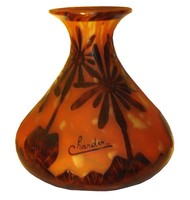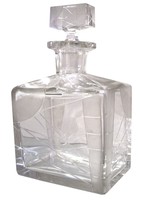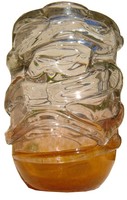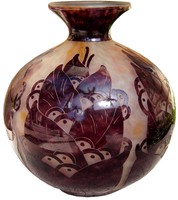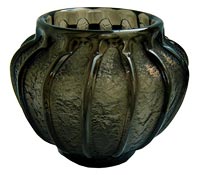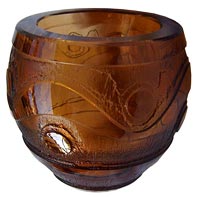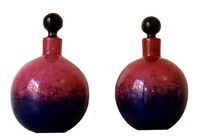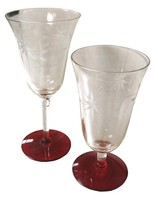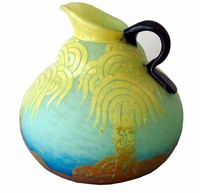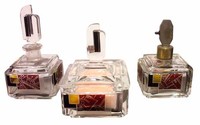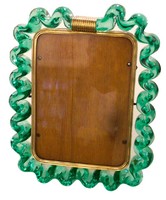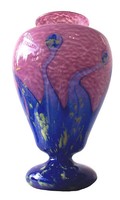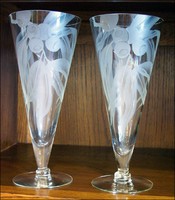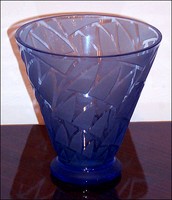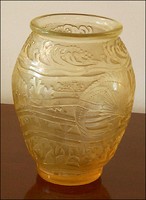Art Deco Glass
Czech Art Deco Crystal Cordial Set for Two
This caramel yellow Art Deco cordial set for two was made in Czechoslovakia in the 1920’s. The tray, decanter and two cups are decorated with geometric patterns alternating frosted and clear crystal. Just the thing for you and someone special to enjoy before retiring. The tray is 8 ½” in diameter and the decanter is 9 ¾” tall. PRICE: $ 450 USD
Jean Luce Ashtray for the SS Normandie
Jean Luce (1895-1964) designed this ashtray for the SS Normandie ca. 1930. The owners of the Normandie, Compagnie Generale Transatlantic, first had the ship’s name on the ashtray, but they disappeared into purses and pockets as souvenirs, they had the name over painted. A third version replaced the name “Normandie” with “French Line”. This version is of tan glass, it has the CGT emblem on top, “French Line” on one side and “Cie Gle Transatlantic” on the other. It is molded on the base “opalex” and “Made in France”. The ashtray is 3 ¼” by 2 ¾”. It is in excellent condition.
A Set of Six Venetian Murano 1950’s Latticino Filigrana Juice Glasses
A set of six fine Venetian Murano juice glasses from the 1950’s. The glasses are decorated in a technique called "Latticino Filigrana Ribbon" with Ribbons of white Latticino bordered by gold and intersected with black lines. The 3 ½" tall glasses have an applied rim foot and are in excellent condition. PRICE: $ 500 USD
Charles Schneider Le Verre Francaise TORTUES French Art Deco Glass Bowl
This French art deco cameo glass bowl was created by Charles SchneiderCharles Schneider
[1881 - 1962]
In 1913, Charles Schneider and his brother established the Cristallerie Schneider at Epnay-sur-Seine, France. Charles had learned his trade as a designer for the great Art Nouveau glass firms of Galle and Daum.
Art glass by Schneider was originally signed Schneider, Le Verre Francaise, or Charder (a contraction of Charles Schneider). Occasionally, it was signed with the inclusion of a small candy-cane of striped glass in the base.
The glass marked "Schneider" was produced from 1913 to 1933 in a variety of shapes and colors, including a new deep orange, which Schneider developed in 1926 and called "Tango". This orange became so popular a color that it was copied in other mediums.
The glass that Schneider produced marked Le Verre Francais (the glass of France), and Charder, was made of two contrasting layers of colored glass. Part of the outer layer was cut away in various Art Deco motifs by acid etching, to reveal the...![]() Click to Read More
Click to Read More
Eight American Art Deco BLUE MOON Cordial Cups by Chase Brass & Copper Company
A set of eight cordial cups designed by Harry Laylon for the Chase Brass & Copper Company in the “Blue Moon” pattern. The cups are # 90067 in the company literature and were available between 1936 – 1941. Each cup in cobalt blue glass and stepped chrome base is 3 ½” tall.
American Art Deco Ruba Rombic Vase
This American art deco Ruba Rombic vase was designed in 1927 by Reuben Haley (1872 – 1933) and introduced in 1928 by the Consolidated Lamp and Glass Company of Coraopolis, Pennsylvania. The Ruba Rombic line was only produced for four years, until 1933. The 9 ½” high vase is in Consolidated’s “silver” color.
American Art Deco Glass Picture Frame
This American art deco free standing table picture frame is from the 1930’s. The beveled glass front is decorated with a simple silver line and is attached to the back by four glass rosettes. The 10" x 12" frame holds an 8" x 10" photo.
Kosta Boda Vase by Goran and Ann Warff
This striking glass vase was designed for Kosta Boda, Swedish glass maker in the 1960’s by Goran Warff (1933 - ) and Ann Warf (1937 - ). The thick walled blown glass vase is of light amber and colorless glass overlaid in pale rose. Heavy red glass has been applied to the front and worked in a relief design. The back has been polished to pass light. The polished base is etched “Kosta 47318 Warff”. The vase is 7 3/8” high and 5 ½” wide. PRICE: $750 USD
Charles Schneider French Art Deco Vase with Inclusions
This French art deco glass vase is by master verrier Charles SchneiderCharles Schneider
[1881 - 1962]
In 1913, Charles Schneider and his brother established the Cristallerie Schneider at Epnay-sur-Seine, France. Charles had learned his trade as a designer for the great Art Nouveau glass firms of Galle and Daum.
Art glass by Schneider was originally signed Schneider, Le Verre Francaise, or Charder (a contraction of Charles Schneider). Occasionally, it was signed with the inclusion of a small candy-cane of striped glass in the base.
The glass marked "Schneider" was produced from 1913 to 1933 in a variety of shapes and colors, including a new deep orange, which Schneider developed in 1926 and called "Tango". This orange became so popular a color that it was copied in other mediums.
The glass that Schneider produced marked Le Verre Francais (the glass of France), and Charder, was made of two contrasting layers of colored glass. Part of the outer layer was cut away in various Art Deco motifs by acid etching, to reveal the...![]() Click to Read More
Click to Read More
French Art Deco Charles Schneider Le Verre Francais Cabinet Vase
This French art deco cameo glass cabinet vase was made between 1922 and 1925 by Master Verrier Charles SchneiderCharles Schneider
[1881 - 1962]
In 1913, Charles Schneider and his brother established the Cristallerie Schneider at Epnay-sur-Seine, France. Charles had learned his trade as a designer for the great Art Nouveau glass firms of Galle and Daum.
Art glass by Schneider was originally signed Schneider, Le Verre Francaise, or Charder (a contraction of Charles Schneider). Occasionally, it was signed with the inclusion of a small candy-cane of striped glass in the base.
The glass marked "Schneider" was produced from 1913 to 1933 in a variety of shapes and colors, including a new deep orange, which Schneider developed in 1926 and called "Tango". This orange became so popular a color that it was copied in other mediums.
The glass that Schneider produced marked Le Verre Francais (the glass of France), and Charder, was made of two contrasting layers of colored glass. Part of the outer layer was cut away in various Art Deco motifs by acid etching, to reveal the...![]() Click to Read More
Click to Read More
French Art Deco Teal Blue Crystal Center Bowl
This French art deco center bowl dates from the 1930’s. Made from translucent teal blue crystal, the bowl sits on a hexagonal base with a faceted stem. The outer edge of the bowl is etched with a geometric design and measures 15 ¼” in diameter and 4 ¾” high.
Charles Scheider French Art Deco Cobalt Blue to Orange Vase
A hand blown glass vase by Charles SchneiderCharles Schneider
[1881 - 1962]
In 1913, Charles Schneider and his brother established the Cristallerie Schneider at Epnay-sur-Seine, France. Charles had learned his trade as a designer for the great Art Nouveau glass firms of Galle and Daum.
Art glass by Schneider was originally signed Schneider, Le Verre Francaise, or Charder (a contraction of Charles Schneider). Occasionally, it was signed with the inclusion of a small candy-cane of striped glass in the base.
The glass marked "Schneider" was produced from 1913 to 1933 in a variety of shapes and colors, including a new deep orange, which Schneider developed in 1926 and called "Tango". This orange became so popular a color that it was copied in other mediums.
The glass that Schneider produced marked Le Verre Francais (the glass of France), and Charder, was made of two contrasting layers of colored glass. Part of the outer layer was cut away in various Art Deco motifs by acid etching, to reveal the...![]() Click to Read More
Click to Read More
French Art Deco Marble & Glass Table Top Picture Frame
Black and white marble with an inlay of burnt orange marble distinguishes this French art deco table top picture frame. The two panes of glass hold the picture securely in place. The frame measures 3 ½” deep x 14” wide and stands 10” high.
Pair French Art Deco Marble Table Top Picture Frames
This pair of 1930’s French art deco table top picture frames have rose and black marble bases and two round chrome standards which support the two panes of glass in each frame. Just slip in your favorite photograph! Each frame measures 2 ½” deep x 7” wide and 8” high.
Muller Freres French Art Deco Geometric Glass Vase
An unusual French art deco molded glass vase by Muller FreresMuller Freres
[Founded in 1895]
(Muller Brothers) in Luneville, France, was one of the premier glassmakers of the period. The Mullers produced art glass competing with Daum and Galle from 1895 till the war intervened in 1914.
Resuming production in 1919, the company concentrated on ceiling fixtures, wall sconces and table lamps. The Depression caused Muller Freres to cease production in 1933 and finally close down in 1936.![]() Click to Read More
Click to Read More
Charles Schneider French Art Deco Cameo Glass Vase
This French art deco cameo glass vase is by Charles SchneiderCharles Schneider
[1881 - 1962]
In 1913, Charles Schneider and his brother established the Cristallerie Schneider at Epnay-sur-Seine, France. Charles had learned his trade as a designer for the great Art Nouveau glass firms of Galle and Daum.
Art glass by Schneider was originally signed Schneider, Le Verre Francaise, or Charder (a contraction of Charles Schneider). Occasionally, it was signed with the inclusion of a small candy-cane of striped glass in the base.
The glass marked "Schneider" was produced from 1913 to 1933 in a variety of shapes and colors, including a new deep orange, which Schneider developed in 1926 and called "Tango". This orange became so popular a color that it was copied in other mediums.
The glass that Schneider produced marked Le Verre Francais (the glass of France), and Charder, was made of two contrasting layers of colored glass. Part of the outer layer was cut away in various Art Deco motifs by acid etching, to reveal the...![]() Click to Read More
Click to Read More
Charles Schneider French Art Deco Monumental Cameo Glass Vase Cardamines
This monumental French Art Deco cameo glass vase was created by Charles SchneiderCharles Schneider
[1881 - 1962]
In 1913, Charles Schneider and his brother established the Cristallerie Schneider at Epnay-sur-Seine, France. Charles had learned his trade as a designer for the great Art Nouveau glass firms of Galle and Daum.
Art glass by Schneider was originally signed Schneider, Le Verre Francaise, or Charder (a contraction of Charles Schneider). Occasionally, it was signed with the inclusion of a small candy-cane of striped glass in the base.
The glass marked "Schneider" was produced from 1913 to 1933 in a variety of shapes and colors, including a new deep orange, which Schneider developed in 1926 and called "Tango". This orange became so popular a color that it was copied in other mediums.
The glass that Schneider produced marked Le Verre Francais (the glass of France), and Charder, was made of two contrasting layers of colored glass. Part of the outer layer was cut away in various Art Deco motifs by acid etching, to reveal the...![]() Click to Read More
Click to Read More
Charles Schneider French Art Deco Monumental Cameo Glass Vase Myrtilles
This monumental French Art Deco cameo glass vase was created by Charles SchneiderCharles Schneider
[1881 - 1962]
In 1913, Charles Schneider and his brother established the Cristallerie Schneider at Epnay-sur-Seine, France. Charles had learned his trade as a designer for the great Art Nouveau glass firms of Galle and Daum.
Art glass by Schneider was originally signed Schneider, Le Verre Francaise, or Charder (a contraction of Charles Schneider). Occasionally, it was signed with the inclusion of a small candy-cane of striped glass in the base.
The glass marked "Schneider" was produced from 1913 to 1933 in a variety of shapes and colors, including a new deep orange, which Schneider developed in 1926 and called "Tango". This orange became so popular a color that it was copied in other mediums.
The glass that Schneider produced marked Le Verre Francais (the glass of France), and Charder, was made of two contrasting layers of colored glass. Part of the outer layer was cut away in various Art Deco motifs by acid etching, to reveal the...![]() Click to Read More
Click to Read More
Editions Etling Opalescent Glass Bowl Geraniums
This French Art Deco signed opalescent glass bowl was produced by the Parisian firm of La Societe Anonyme Edmond Etling which was founded after WWI in Paris, France and made at the Choisy-le-Roi glassworks which were located just outside of Paris. The beautifully molded 1” thick glass pattern of geraniums is on the base of the bowl and the petal clusters serve as the feet of the bowl, leaving the inside of the bowl with a smooth surface. Etling produced the work of some of the top designers of the Art Deco era. Geza Hiecz and Georges Beal were some of the Etling designers as well as Lucille Sevin, Genevieve Granger, Maurice Guiraud and Demetre Chiparus. The company did not survive WWII so all its production was in the 1920’s and 1930’s. The bowl is marked “Etling France 146” in the mold. The “146” pertains to the catalog number assigned to it by Etling. The diameter of the bowl is 11 ¾” and it’s 2 ¾” tall. $ 1,250.00 SALE PRICE: $ 750.00 /
George Sakier American Art Deco Vase in Ebony 1930
This American Art Deco Glass vase was designed in 1930 by George Sakier (1897 -1988) for the Fostoria Glass Company, Moundsville, West Virginia. Known as the number 2404 Art Deco Vase, it is 5 1/2" high and 7 1/2" wide. It is in Fostoria's Ebony color and is in excellent condition.
George Sakier 1929 Lotus Vase in Topaz # 2428
This rare Art Deco number 2428 Lotus Vase was designed by George Sakier (1897 - 1988) for the Fostoria Glass Company, Moundsville, West Virginia in 1929. The 4 1/2" high, 6 7/8" diameter vase is in the Topaz color. A similar vase in form and color is pictured in "A Modern World, American Design from the Yale University Art Gallery". The vase is in excellent condition.
George Sakier for Fostoria Service for Six
This forty six piece luncheon set for six designed in 1929 and 1930 by George Sakier (1897-1988). It was produced by the Fostoria Glass Company of Moundsville, West Virginia. The set consists of: 6 4020 Goblets 6 4020 Juice Glasses 6 4020 Low Sherberts 6 2419 8” Mayfair Plates 6 2419 7” Mayfair Plates 6 2419 5 ½” Mayfair Plates 6 2402 4” Fruit Bowls 2 2402 8 ½” Serving Bowls 2 2402 Candlesticks
George Sakier for Fostoria After Dinner Service for Four
George Sakier (1897-1988) designed this twenty four piece service for four in 1929 and 1930. It was produced by the Fostoria Glass Company of Moundsville, West Virginia. The set consists of: 4 2419 Mayfair Cups 4 2419 Mayfair Saucers 4 4020 Champagne Glasses 4 4020 Low Sherberts 4 4020 Cordials 2 2447 Duo Candlesticks 1 4020 Sugar and Creamer
Charles Schneider Cameo Glass Begonias Vase
This cameo glass vase was created by charles schneider (1881-1958) for his Le Verre Francais line. The vase, in the “begonias” cutting was produced from 1922 to 1925. A yellow ground overlaid with blue glass shading to orange toward the foot is etched to reveal the pattern. The 8 ?” high vase is inscribed on the foot “Le verre Francais”.
Charles Schneider Cameo Glass “Pavots” Vase
Charles SchneiderCharles Schneider
[1881 - 1962]
In 1913, Charles Schneider and his brother established the Cristallerie Schneider at Epnay-sur-Seine, France. Charles had learned his trade as a designer for the great Art Nouveau glass firms of Galle and Daum.
Art glass by Schneider was originally signed Schneider, Le Verre Francaise, or Charder (a contraction of Charles Schneider). Occasionally, it was signed with the inclusion of a small candy-cane of striped glass in the base.
The glass marked "Schneider" was produced from 1913 to 1933 in a variety of shapes and colors, including a new deep orange, which Schneider developed in 1926 and called "Tango". This orange became so popular a color that it was copied in other mediums.
The glass that Schneider produced marked Le Verre Francais (the glass of France), and Charder, was made of two contrasting layers of colored glass. Part of the outer layer was cut away in various Art Deco motifs by acid etching, to reveal the...![]() Click to Read More
Click to Read More
Charles Schneider Le Verre Francais Coprins Vase
Charles SchneiderCharles Schneider
[1881 - 1962]
In 1913, Charles Schneider and his brother established the Cristallerie Schneider at Epnay-sur-Seine, France. Charles had learned his trade as a designer for the great Art Nouveau glass firms of Galle and Daum.
Art glass by Schneider was originally signed Schneider, Le Verre Francaise, or Charder (a contraction of Charles Schneider). Occasionally, it was signed with the inclusion of a small candy-cane of striped glass in the base.
The glass marked "Schneider" was produced from 1913 to 1933 in a variety of shapes and colors, including a new deep orange, which Schneider developed in 1926 and called "Tango". This orange became so popular a color that it was copied in other mediums.
The glass that Schneider produced marked Le Verre Francais (the glass of France), and Charder, was made of two contrasting layers of colored glass. Part of the outer layer was cut away in various Art Deco motifs by acid etching, to reveal the...![]() Click to Read More
Click to Read More
Charles Schneider French Art Deco Orange Vase
This internally decorated case was created by Charles SchneiderCharles Schneider
[1881 - 1962]
In 1913, Charles Schneider and his brother established the Cristallerie Schneider at Epnay-sur-Seine, France. Charles had learned his trade as a designer for the great Art Nouveau glass firms of Galle and Daum.
Art glass by Schneider was originally signed Schneider, Le Verre Francaise, or Charder (a contraction of Charles Schneider). Occasionally, it was signed with the inclusion of a small candy-cane of striped glass in the base.
The glass marked "Schneider" was produced from 1913 to 1933 in a variety of shapes and colors, including a new deep orange, which Schneider developed in 1926 and called "Tango". This orange became so popular a color that it was copied in other mediums.
The glass that Schneider produced marked Le Verre Francais (the glass of France), and Charder, was made of two contrasting layers of colored glass. Part of the outer layer was cut away in various Art Deco motifs by acid etching, to reveal the...![]() Click to Read More
Click to Read More
Czech Leaded Glass Dresser Set
A striking czech leaded glass dresser set from the 1930’s. The set has a powder jar, two perfume or cologne bottles and a spray atomizer. The set is clear glass with red enamel, the enamel is highlight by a series of wheel cut lines, the body and finials are faceted. the tallest is 5 ¼” high.
Charles Schneider Vase Pair
Charles SchneiderCharles Schneider
[1881 - 1962]
In 1913, Charles Schneider and his brother established the Cristallerie Schneider at Epnay-sur-Seine, France. Charles had learned his trade as a designer for the great Art Nouveau glass firms of Galle and Daum.
Art glass by Schneider was originally signed Schneider, Le Verre Francaise, or Charder (a contraction of Charles Schneider). Occasionally, it was signed with the inclusion of a small candy-cane of striped glass in the base.
The glass marked "Schneider" was produced from 1913 to 1933 in a variety of shapes and colors, including a new deep orange, which Schneider developed in 1926 and called "Tango". This orange became so popular a color that it was copied in other mediums.
The glass that Schneider produced marked Le Verre Francais (the glass of France), and Charder, was made of two contrasting layers of colored glass. Part of the outer layer was cut away in various Art Deco motifs by acid etching, to reveal the...![]() Click to Read More
Click to Read More
Monumental Degue Vase By Gueron
This French art deco vase was designed by David Gueron (1882-1950) for his company “Verrerie d’Art Degue”, located in Paris at 41 avenue de Paris, whith his glass works fifty miles north in Compiegne*. Gueron named his glass “Degue” which is a play on his name and means “of Gue”. This vase was made from glass powders and mouth blown. The yellow ground was overlaid in dark blue (at the base) ocher (on the middle) and a mottled royal blue (at the top) then acid etched to reveal the geometric floral scene. The vase is signed on the foot “degue” and is 17 ¾” tall and 9 ½” in diameter. *Verreier d’Art Degue was opened in 1926 and stopped work in 1936 due to the effects of the depression and a prolonged lawsuit with the firm of Charles Schneider.
Monumental Degue Vase by Cazaux
In 1928 the famed ceramicist, Edouard Cazaux (1889-1974) began working with David Gueron (1882-1950) at the Verrerier d’Art Degue in Paris. While Gueron’s designs were floral in nature, Cazaux designs were geometric. This vase is a superb example of Cazaux’s work. The mottled orange glass ground is covered with a layer of royal blue glass, which is then acid etched to create the striking design. The vase is signed on the foot “degue” and is 18” tall and 8” in diameter.
Charles Schneider Le Verre Francais Lavande Etched Vase
Charles SchneiderCharles Schneider
[1881 - 1962]
In 1913, Charles Schneider and his brother established the Cristallerie Schneider at Epnay-sur-Seine, France. Charles had learned his trade as a designer for the great Art Nouveau glass firms of Galle and Daum.
Art glass by Schneider was originally signed Schneider, Le Verre Francaise, or Charder (a contraction of Charles Schneider). Occasionally, it was signed with the inclusion of a small candy-cane of striped glass in the base.
The glass marked "Schneider" was produced from 1913 to 1933 in a variety of shapes and colors, including a new deep orange, which Schneider developed in 1926 and called "Tango". This orange became so popular a color that it was copied in other mediums.
The glass that Schneider produced marked Le Verre Francais (the glass of France), and Charder, was made of two contrasting layers of colored glass. Part of the outer layer was cut away in various Art Deco motifs by acid etching, to reveal the...![]() Click to Read More
Click to Read More
Charles Schneider Art Deco Pitcher
Charles SchneiderCharles Schneider
[1881 - 1962]
In 1913, Charles Schneider and his brother established the Cristallerie Schneider at Epnay-sur-Seine, France. Charles had learned his trade as a designer for the great Art Nouveau glass firms of Galle and Daum.
Art glass by Schneider was originally signed Schneider, Le Verre Francaise, or Charder (a contraction of Charles Schneider). Occasionally, it was signed with the inclusion of a small candy-cane of striped glass in the base.
The glass marked "Schneider" was produced from 1913 to 1933 in a variety of shapes and colors, including a new deep orange, which Schneider developed in 1926 and called "Tango". This orange became so popular a color that it was copied in other mediums.
The glass that Schneider produced marked Le Verre Francais (the glass of France), and Charder, was made of two contrasting layers of colored glass. Part of the outer layer was cut away in various Art Deco motifs by acid etching, to reveal the...![]() Click to Read More
Click to Read More
Czechoslovakian Art Deco Decanter
A wonderful example of a 1930's Czechoslovakian art deco glass work. The decanter has seventeen surfaces, not counting the stopper. The angularity of the form is heightened with geometric black enamel work and wheel cut incised lines. The decanter is in mint condition and probably never held liquid. It is 9" high.
Charles Schneider Art Deco Cameo Glass Vase
A French art deco cameo glass vase by Charles SchneiderCharles Schneider
[1881 - 1962]
In 1913, Charles Schneider and his brother established the Cristallerie Schneider at Epnay-sur-Seine, France. Charles had learned his trade as a designer for the great Art Nouveau glass firms of Galle and Daum.
Art glass by Schneider was originally signed Schneider, Le Verre Francaise, or Charder (a contraction of Charles Schneider). Occasionally, it was signed with the inclusion of a small candy-cane of striped glass in the base.
The glass marked "Schneider" was produced from 1913 to 1933 in a variety of shapes and colors, including a new deep orange, which Schneider developed in 1926 and called "Tango". This orange became so popular a color that it was copied in other mediums.
The glass that Schneider produced marked Le Verre Francais (the glass of France), and Charder, was made of two contrasting layers of colored glass. Part of the outer layer was cut away in various Art Deco motifs by acid etching, to reveal the...![]() Click to Read More
Click to Read More
Charles Schneider Compote
Charles SchneiderCharles Schneider
[1881 - 1962]
In 1913, Charles Schneider and his brother established the Cristallerie Schneider at Epnay-sur-Seine, France. Charles had learned his trade as a designer for the great Art Nouveau glass firms of Galle and Daum.
Art glass by Schneider was originally signed Schneider, Le Verre Francaise, or Charder (a contraction of Charles Schneider). Occasionally, it was signed with the inclusion of a small candy-cane of striped glass in the base.
The glass marked "Schneider" was produced from 1913 to 1933 in a variety of shapes and colors, including a new deep orange, which Schneider developed in 1926 and called "Tango". This orange became so popular a color that it was copied in other mediums.
The glass that Schneider produced marked Le Verre Francais (the glass of France), and Charder, was made of two contrasting layers of colored glass. Part of the outer layer was cut away in various Art Deco motifs by acid etching, to reveal the...![]() Click to Read More
Click to Read More
George Sakier American Art Deco Vase
This American art deco vase was designed in 1930 by George Sakier (1897-1988) for the Fostoria Glass Company, Moundsville, West Virginia. Known as the number 2404 Art Deco Vase, the vase is 5 ½” high and 7 ½” wide. It is in Fostoria’s ebony color and is in excellent condition.
George Sakier Lotus Vase
This American art deco vase was designed in 1929 by George Sakier (1897-1988) for the Fostoria Glass Company, Mundsville, West Virginia. Known as the number 2429 “Lotus” vase, the vase is in ebony and is 9 ½” tall and 3 ½” in diameter. It is in excellent condition. Sakier’s Lotus vases are in the collections of The Yale University Art Gallery, The Metropolitan Museum of Art and The Smithsonian, Cooper Hewitt National Design Museum.
George Sakier Complete Service for Six
George Sakier (1897-1988) designed this very art deco 72 piece service for the Fostoria Glass Company, Moundsville, West Virginia in 1929 and 1930. The drinking vessels are from his 4020 line and feature a square ebony foot with stacked ebony stem and crystal bowl, the sugar and creamer are from the same line. The three sizes of plates are in ebony glass and are from his Mayfair line, as are the ebony glass cups and saucers. The two large serving bowls, the six ramekins and the two candle holders are all in ebony glass from his 2402 line.
Pair of French Art Deco Asymmetrical Double Candlesticks
This pair of French art deco asymmetrical candlesticks was made by Cristallerie Lorraine, France which was founded in 1925. The heavy and impressive candlesticks have a polished pontil on the bottom with an acid stamp “Cristallerie Lorraine” in a circle. Typically this house has a 24-30% lead content in their crystal insuring a bright clear product. Each stick is 11 ½” high and 9” wide.
American Art Deco Vase By George Sakier
This American art deco vase was designed by George Sakier (1897-1988) for the Fostoria Glass Company, Moundsville, West Virginia in 1929. The Vase number 2428 in the company literature is in the rare wisteria color and is 9 3/8" tall. It is in perfect condition.
American Art Deco Vase by George Sakier for Fostoria
This rare American art deco vase was designed by George Sakier (1897-1988) for the Fostoria Glass Company, Moundsville, West Virginia. The vase is number 2408 in the company literature. The form was introduced in 1930 and is in the green color which was discontinued in 1941. A vase of the same form is in the British Museum in London. The vase is in excellent condition with the exception of a small bubble in the glass from manufacture. The vase is 8 ¼ high.
Six Mexican Silver Overlay Brandy Snifters
This set of six Mexican silver overlay brandy snifters are from the 1940's. Each glass has a fantastic bird or fish in silver on it. The animals relate to precolombian myths. The glass and siver are in excellent condition. Each snifter is 4.5" high.
American Art Deco Sterling Overlay Leaping Stag Ice Bucket
This American art deco ice bucket dates from the late 1920’s. Sterling silver on Cambridge black glass produces a floral and foliate design with an iconic Leaping Stag inside a center medallion. The silver band around the top rim supports a raffia covered handle. The bucket is 6” high and 5 ¼” in diameter at the top. It is in excellent original condition.
French Art Deco Bronze and Etched Glass Firescreen
This French art deco firescreen has a bronze frame with asymmetric sides with a “Waterfall” décor. The frame sits on the four feet; the center two stepped, the outer two with a curved side flange. The ½” inch glass is etched with a fantastic creature amid swirls and geometric circles depicting the North Wind. The screen is 48” wide, 29 ½” high and 7” deep (at the feet).
American Art Deco Ruba Rombic Tumblers
This set of four American art deco drinking glasses was designed in 1927 by Reuben Haley (1872 - 1933) for the Consolidated & Lamp Glass Company of Coraopolis, Pennsylvania. The 9 oz tumblers, in jungle green, are number 813 in the company catalog. Each 4” tall glass is in excellent condition.
French Art Deco Decanter Set
A French art deco decanter and six cordials in frosted and polished crystal glass. The decanter measures 11 ¾” high and the cordials 2 ¾” high each.
American Art Deco Ruba Romboic SmokeyTopaz Bon Bon Bowl
This cubistic American art deco divided glass bowl was designed by Reuben Haley (1872 - 1933) for the Consolidated Lamp Glass Company. The company named the color "Smokey Topaz". It is divided into three parts and is known as the number "852 bon - bon". The bowl, which was introduced in 1928, is 8" x 6 3/8" and is 2" high.
Benny Motzfeld Norwegian Glass Vase
This sophicated norwegian glass vase was designed and made by Benny Motzfeld (1901 - 1995). She was called “Today the most collected Norwegian glass artist”. The blown waisted vase of colorless glass is internally decorated with gold inclusions and trapped bubbles and was made ca 1965. The polished pontil is acid stamped “plus”, “BM” and “Norway”. The vase is 4” high and 7” diameter.
French Art Deco Ice Bucket in the Style of Maurice Marinot
This lovely 1930's French art deco ice bucket is in the style of Maurice Marinot (1882 - 1960). The thick walled glass body internally decorated with random bubbles is punctuated by two applied lug handles. The bucket is 8" high and 7 1/2" in diameter (10" at the handles).
French Art Deco Acid Etched Geometric Design Yellow Glass Vase
This very geometric French art deco vase is of translucent yellow glass. The vase has four ribbed wings on each side and four acid etched bands circling the body, separated by speed lines. Standing 8 ¼” high and 6” in diameter, the vase is 7 ½” across at the wings.
Charles Schneider French Art Deco Cameo Glass Vase PRUNES
This French art deco cameo glass vase from the Barbra Streisand Collection was created by Charles SchneiderCharles Schneider
[1881 - 1962]
In 1913, Charles Schneider and his brother established the Cristallerie Schneider at Epnay-sur-Seine, France. Charles had learned his trade as a designer for the great Art Nouveau glass firms of Galle and Daum.
Art glass by Schneider was originally signed Schneider, Le Verre Francaise, or Charder (a contraction of Charles Schneider). Occasionally, it was signed with the inclusion of a small candy-cane of striped glass in the base.
The glass marked "Schneider" was produced from 1913 to 1933 in a variety of shapes and colors, including a new deep orange, which Schneider developed in 1926 and called "Tango". This orange became so popular a color that it was copied in other mediums.
The glass that Schneider produced marked Le Verre Francais (the glass of France), and Charder, was made of two contrasting layers of colored glass. Part of the outer layer was cut away in various Art Deco motifs by acid etching, to reveal the...![]() Click to Read More
Click to Read More
Charles Schneider French Art Deco CHARDER FOUGERES Cameo Glass Vase
This impressive French art deco cameo glass vase was created by Charles SchneiderCharles Schneider
[1881 - 1962]
In 1913, Charles Schneider and his brother established the Cristallerie Schneider at Epnay-sur-Seine, France. Charles had learned his trade as a designer for the great Art Nouveau glass firms of Galle and Daum.
Art glass by Schneider was originally signed Schneider, Le Verre Francaise, or Charder (a contraction of Charles Schneider). Occasionally, it was signed with the inclusion of a small candy-cane of striped glass in the base.
The glass marked "Schneider" was produced from 1913 to 1933 in a variety of shapes and colors, including a new deep orange, which Schneider developed in 1926 and called "Tango". This orange became so popular a color that it was copied in other mediums.
The glass that Schneider produced marked Le Verre Francais (the glass of France), and Charder, was made of two contrasting layers of colored glass. Part of the outer layer was cut away in various Art Deco motifs by acid etching, to reveal the...![]() Click to Read More
Click to Read More
DEGUE French Art Deco Blue Cameo Glass Vase by Cazaux
This French art deco cameo glass vase was designed by Edouard Cazaux 1889 – 1974) ca. 1930 for “Verrerier d’Art Degue”. A shimmering blue translucent glass is acid cut in a geometric pattern to reveal the lower layer of textured and frosted colorless glass. In 1926 David Gueron, who owned “Cristalleries de Compiègne, entered the art glass business and named his business “Verrerie d’Art Degue”. In 1928 Cazaux joined him and designed special pieces with strong deco and geometric themes…this is one of those pieces. The 10” high vase is signed in cameo “Degue”.
Large French Art Deco DEGUE Violet Cameo Glass Vase by Cazaux
This large French art deco cameo glass vase was designed by Edouard Cazaux (1889 – 1974) ca. 1930 for “Verrerie d’Art Degue”. A lovely violet translucent glass is acid cut in a geometric pattern to reveal the lower layer of frosted colorless glass. In 1926 David Gueron who owned “Cristalleries de Campaigne” entered the art glass business and named his company “Verrerie d’Art Degue”. In 1928 Cazaux joined him and designed special pieces with strong deco and geometric themes….this is one of those pieces. The 14 ¾” tall vase is signed in Cameo “Degue”
Charles Schneider French Art Deco CHARDER ROSACES Cameo Glass Vase Le Verre
This exciting French art deco cameo glass vase was created by Charles SchneiderCharles Schneider
[1881 - 1962]
In 1913, Charles Schneider and his brother established the Cristallerie Schneider at Epnay-sur-Seine, France. Charles had learned his trade as a designer for the great Art Nouveau glass firms of Galle and Daum.
Art glass by Schneider was originally signed Schneider, Le Verre Francaise, or Charder (a contraction of Charles Schneider). Occasionally, it was signed with the inclusion of a small candy-cane of striped glass in the base.
The glass marked "Schneider" was produced from 1913 to 1933 in a variety of shapes and colors, including a new deep orange, which Schneider developed in 1926 and called "Tango". This orange became so popular a color that it was copied in other mediums.
The glass that Schneider produced marked Le Verre Francais (the glass of France), and Charder, was made of two contrasting layers of colored glass. Part of the outer layer was cut away in various Art Deco motifs by acid etching, to reveal the...![]() Click to Read More
Click to Read More
Charles Schneider French Art Deco COCOTIERS Vase Le Verre Francais
This remarkable French art deco cameo glass vase of great presence was created by Charles SchneiderCharles Schneider
[1881 - 1962]
In 1913, Charles Schneider and his brother established the Cristallerie Schneider at Epnay-sur-Seine, France. Charles had learned his trade as a designer for the great Art Nouveau glass firms of Galle and Daum.
Art glass by Schneider was originally signed Schneider, Le Verre Francaise, or Charder (a contraction of Charles Schneider). Occasionally, it was signed with the inclusion of a small candy-cane of striped glass in the base.
The glass marked "Schneider" was produced from 1913 to 1933 in a variety of shapes and colors, including a new deep orange, which Schneider developed in 1926 and called "Tango". This orange became so popular a color that it was copied in other mediums.
The glass that Schneider produced marked Le Verre Francais (the glass of France), and Charder, was made of two contrasting layers of colored glass. Part of the outer layer was cut away in various Art Deco motifs by acid etching, to reveal the...![]() Click to Read More
Click to Read More
Charles Schneider French Art Deco PALMIERS JAUNES Le Verre Francais Vase
This exceptional French art deco cameo glass vase was created by Charles SchneiderCharles Schneider
[1881 - 1962]
In 1913, Charles Schneider and his brother established the Cristallerie Schneider at Epnay-sur-Seine, France. Charles had learned his trade as a designer for the great Art Nouveau glass firms of Galle and Daum.
Art glass by Schneider was originally signed Schneider, Le Verre Francaise, or Charder (a contraction of Charles Schneider). Occasionally, it was signed with the inclusion of a small candy-cane of striped glass in the base.
The glass marked "Schneider" was produced from 1913 to 1933 in a variety of shapes and colors, including a new deep orange, which Schneider developed in 1926 and called "Tango". This orange became so popular a color that it was copied in other mediums.
The glass that Schneider produced marked Le Verre Francais (the glass of France), and Charder, was made of two contrasting layers of colored glass. Part of the outer layer was cut away in various Art Deco motifs by acid etching, to reveal the...![]() Click to Read More
Click to Read More
American Art Deco Black Glass and Sterling Overlay Cocktail Shaker
This is one awesome American Art Deco cocktail shaker. The tall (15 ½”) shaker is made of black glass with a Sterling silver overlay scene of three very art deco geese flying in formation over cattails. The silver overlay is by the Rockwell Silver Company of Meriden, CT. A silver neck and pouring cap and red Bakelite finial sit atop the shaker. The Rockwell shield is acid stamped on the bottom. The shaker is in excellent (probably unused) condition.
Charles Schneider French Art Deco Cameo Glass Coupe CHATS Le Verre Francais
This important French art deco cameo glass coupe from the Barbra Streisand Collection was created between 1922 - 1924 by Charles SchneiderCharles Schneider
[1881 - 1962]
In 1913, Charles Schneider and his brother established the Cristallerie Schneider at Epnay-sur-Seine, France. Charles had learned his trade as a designer for the great Art Nouveau glass firms of Galle and Daum.
Art glass by Schneider was originally signed Schneider, Le Verre Francaise, or Charder (a contraction of Charles Schneider). Occasionally, it was signed with the inclusion of a small candy-cane of striped glass in the base.
The glass marked "Schneider" was produced from 1913 to 1933 in a variety of shapes and colors, including a new deep orange, which Schneider developed in 1926 and called "Tango". This orange became so popular a color that it was copied in other mediums.
The glass that Schneider produced marked Le Verre Francais (the glass of France), and Charder, was made of two contrasting layers of colored glass. Part of the outer layer was cut away in various Art Deco motifs by acid etching, to reveal the...![]() Click to Read More
Click to Read More
Italian Art Glass Pulcino by Alessandro Pianon for Vetreria Vistosi # 193
This cute orange glass bird PULCINO was created in 1963 by Alessandro Pianon (1931 - 1984) for the Italian Murano glass firm, Vetreria Vistosi and numbered model 193 in their catalog. The bird has a textured glass body, clear glass thighs, copper legs and Millefiiore eyes. He measures 5 ½” x 4 ¾” and stands 9” tall.
DAUM French Art Deco Cameo Glass Vase
This striking French art deco cameo glass vase is by the Daum firm of Nancy. The upper layer of orange yellow glass is acid etched to reveal the orange lower layer and create a design of geometric chrysanthemums in bloom. In addition to the color contrast, the upper layer is highly polished while the lower layer has a mat textural finish. The vase is signed on the base “Daum Nancy, France” with the Cross of Lorraine and it measures 7 1/2” high.
Set of Twelve American Art Deco NEW ERA Glasses
These twelve American Art Deco wine goblets were made by the Heisey Company of Newark, Ohio between 1934 and 1941. They are from their “New Era” line, number 4044. Each glass measures 6 ½” tall and all are in excellent condition.
Walter Dorwin Teague for Steuben American Art Deco Vase
Walter Dorwin Teague (1883 – 1960) designed the American art deco vase for Steuben in 1932. The transparent glass is wheel cut with horizontal lines in an ascending-descending checkerboard pattern. This rare vase measures 6 ½” in diameter and is 6” high.
Six Jugendstil PALLME-KONIG Nut Bowls or Dishes
A great set of six Czechoslovakian Jugendstil art glass nut bowls made by the firm Pallme-Konig und Habel. Constructed of translucent iridized green glass with maroon/purplish veining, the dishes have a reticulated top and polished bottom. Each measures 4” square and 2 ½” high.
Swedish Art Deco Emerald Green Etched Glass Vase
This smart Swedish art deco emerald green mold blown glass vase dates to the 1930’s. The front panel has a wheel cut nude image of a young lady reclining on a rock and looking at a bright shining sun while a seagull flies overhead. The vase has six ribs on each flaring side and is acid marked in the ground poitil “Sweden” and etched “1344/591” on the base. The vase measures 8 ¾” tall, 8 ½” wide at the top and 3 ½” deep.
Set of Six Walter Dorwin Teague American Art Deco Embassy Cordials
This rare and important set of American art deco cordials was designed in 1939 by Walter Dorwin Teague (1883 – 1960) and Edwin W. Fuerst (1903 – 1988) working for the Libbey Glass Company for the State dining room in the Federal Building at the 1939 World’s Fair. After the Fair closed in 1940 Libbey entered the forms in their catalogue as the 4900 “Embassy” Line. Hand crafted of “fine Crystal”, the cordials have a mold blown bowl on a cast column and foot. The stems are modeled after Doric columns on the World’s Fair Federal Building which Teague also designed. Fuerst and Teague applied for a design patent in May of 1939 and Patent Number 118,620 was issued in January 1940. The six cordials are in excellent condition.
Eighteen Walter Dorwn Teague American Art Deco Embassy Stems
This rare and important set of American art deco glasses was designed in 1939 by Walter Dorwin Teague (1883 – 1960) and Edwin W. Fuerst (1903 – 1988) working for the Libbey Glass Company for the State dining room in the Federal Building at the 1939 World’s Fair. The set consists of six goblets, six saucer champagnes and six cordials. After the Fair closed in 1940 Libbey entered the forms in their catalogue as the 4900 “Embassy” Line. Hand crafted of “fine Crystal”, the glasses have a mold blown bowl on a cast column and foot. The stems (which are the same height throughout the line) are modeled after Doric columns on the World’s Fair Federal Building which Teague also designed. Fuerst and Teague applied for a design patent in May of 1939 and Patent Number 118,620 was issued in January 1940. The eighteen glasses are in excellent condition.
Degue French Art Deco Cameo Glass Vase
This French art deco cameo glass vase was designed by David Gueron for his own company "Verre d'Art Degue", known as "Degue". The company, founded in 1926, lasted only until 1939 when Gueron closed the factory and fled the Nazis. The mouth blown spherical vase sits on a cushion foot. The frosted white glass ground is overlaid with deep purple glass on the foot to a brillian reddish orange glass above. The upper layer is acid etched away to create a field of stylized tulips. The vase is signed "Degue" and "Made in France". The vase measures 9 1/4" high and 8" in diameter.
Charles Schneider French Art Deco Cocotiers Glass Vase
Charles SchneiderCharles Schneider
[1881 - 1962]
In 1913, Charles Schneider and his brother established the Cristallerie Schneider at Epnay-sur-Seine, France. Charles had learned his trade as a designer for the great Art Nouveau glass firms of Galle and Daum.
Art glass by Schneider was originally signed Schneider, Le Verre Francaise, or Charder (a contraction of Charles Schneider). Occasionally, it was signed with the inclusion of a small candy-cane of striped glass in the base.
The glass marked "Schneider" was produced from 1913 to 1933 in a variety of shapes and colors, including a new deep orange, which Schneider developed in 1926 and called "Tango". This orange became so popular a color that it was copied in other mediums.
The glass that Schneider produced marked Le Verre Francais (the glass of France), and Charder, was made of two contrasting layers of colored glass. Part of the outer layer was cut away in various Art Deco motifs by acid etching, to reveal the...![]() Click to Read More
Click to Read More
French Art Deco Crystal Decanter with Geometric Design
If you are going to have one decanter…this is the one to have! This French art deco heavy lead crystal decanter dates from the 1930’s and carries an elegant geometric décor. Using the unique rectangular body, the glass master decorated with wheel cutting and acid frosting to construct an unusual but simple design. From the body, the shoulder rises in eight planes to a ribbed neck with generous lip. The rectangular stopper echoes the cut and frosted body. The decanter is 9 ¼” high and is in perfect condition.
French Art Deco Geometric Flowers Vase
This French art deco frosted glass vase is from the 1930’s. The raised decoration is of geometric flower heads across the upper portion and geometric ferns around the base. The vase is marked on the bottom “France” and is 11” high.
Charles Schneider French Art Deco
This French art deco glass vase from the 1940’s is by Charles SchneiderCharles Schneider
[1881 - 1962]
In 1913, Charles Schneider and his brother established the Cristallerie Schneider at Epnay-sur-Seine, France. Charles had learned his trade as a designer for the great Art Nouveau glass firms of Galle and Daum.
Art glass by Schneider was originally signed Schneider, Le Verre Francaise, or Charder (a contraction of Charles Schneider). Occasionally, it was signed with the inclusion of a small candy-cane of striped glass in the base.
The glass marked "Schneider" was produced from 1913 to 1933 in a variety of shapes and colors, including a new deep orange, which Schneider developed in 1926 and called "Tango". This orange became so popular a color that it was copied in other mediums.
The glass that Schneider produced marked Le Verre Francais (the glass of France), and Charder, was made of two contrasting layers of colored glass. Part of the outer layer was cut away in various Art Deco motifs by acid etching, to reveal the...![]() Click to Read More
Click to Read More
Charles Schneider Art Deco Cameo Glass Vase
This French art deco cameo glass vase is by Charles SchneiderCharles Schneider
[1881 - 1962]
In 1913, Charles Schneider and his brother established the Cristallerie Schneider at Epnay-sur-Seine, France. Charles had learned his trade as a designer for the great Art Nouveau glass firms of Galle and Daum.
Art glass by Schneider was originally signed Schneider, Le Verre Francaise, or Charder (a contraction of Charles Schneider). Occasionally, it was signed with the inclusion of a small candy-cane of striped glass in the base.
The glass marked "Schneider" was produced from 1913 to 1933 in a variety of shapes and colors, including a new deep orange, which Schneider developed in 1926 and called "Tango". This orange became so popular a color that it was copied in other mediums.
The glass that Schneider produced marked Le Verre Francais (the glass of France), and Charder, was made of two contrasting layers of colored glass. Part of the outer layer was cut away in various Art Deco motifs by acid etching, to reveal the...![]() Click to Read More
Click to Read More
French Art Deco Cameo Glass Vase By Charles Schneider
This French art deco cameo glass vase is by Charles SchneiderCharles Schneider
[1881 - 1962]
In 1913, Charles Schneider and his brother established the Cristallerie Schneider at Epnay-sur-Seine, France. Charles had learned his trade as a designer for the great Art Nouveau glass firms of Galle and Daum.
Art glass by Schneider was originally signed Schneider, Le Verre Francaise, or Charder (a contraction of Charles Schneider). Occasionally, it was signed with the inclusion of a small candy-cane of striped glass in the base.
The glass marked "Schneider" was produced from 1913 to 1933 in a variety of shapes and colors, including a new deep orange, which Schneider developed in 1926 and called "Tango". This orange became so popular a color that it was copied in other mediums.
The glass that Schneider produced marked Le Verre Francais (the glass of France), and Charder, was made of two contrasting layers of colored glass. Part of the outer layer was cut away in various Art Deco motifs by acid etching, to reveal the...![]() Click to Read More
Click to Read More
Charles Schneider French Art Deco Cameo Glass Vase
This French art deco cameo glass vase is by Charles SchneiderCharles Schneider
[1881 - 1962]
In 1913, Charles Schneider and his brother established the Cristallerie Schneider at Epnay-sur-Seine, France. Charles had learned his trade as a designer for the great Art Nouveau glass firms of Galle and Daum.
Art glass by Schneider was originally signed Schneider, Le Verre Francaise, or Charder (a contraction of Charles Schneider). Occasionally, it was signed with the inclusion of a small candy-cane of striped glass in the base.
The glass marked "Schneider" was produced from 1913 to 1933 in a variety of shapes and colors, including a new deep orange, which Schneider developed in 1926 and called "Tango". This orange became so popular a color that it was copied in other mediums.
The glass that Schneider produced marked Le Verre Francais (the glass of France), and Charder, was made of two contrasting layers of colored glass. Part of the outer layer was cut away in various Art Deco motifs by acid etching, to reveal the...![]() Click to Read More
Click to Read More
Daum Vase in Olive Green
This French art deco olive green glass vase is by Daum Freres and is from the 1930’s. The vase, which narrows in diameter at the top and base, has fifteen ribs of polished glass against an acid etched ground. The top rim, base and foot are polished. The vase is signed on the bottom “Daum Nancy” with the Cross of Lorraine and measures 6” tall and 7” in diameter.
Daum Vase in Peach
A very special Daum Freres French art deco peach glass vase. The vase dates from the 1930’s, has very thick walls with a polished swirling band and polished circles against an acid etched background. Three circular bands (top, lower and base) complete the design. The vase is signed “Daum Nancy France” with the cross of Lorraine on the bottom band. The vase is 5 ½” tall and 5 ½” in diameter.
Green Daum Vase
A wonderful French Art Deco vase in pale green glass. The vase, by Daum Freres is acid etched in a geometric design. Signed “Daum, Nancy, France” with the cross of Loraine, the vase is 6-3/4” high and 5-1/4” across the lip.
American Art Deco Ruba Rombic Bowl
This American Art Deco bowl was designed in 1927 by Reuben Haley for the Consolidated Glass Company of Corapolis, PA. His Ruba Rombic line was introduced in 1928 and retired in 1933. It has been estimated that only 1500 pieces of Ruba Rombic have survived. This piece is the oblong bowl (also called the banana bowl) and it is in a striking jungle green and is 12” long and 4-1/8” high.
Pair Orme Candlesticks
This pair of clear glass American art deco candlesticks was designed by Wilber L. Orme (1889 – 1972) for the Cambridge Glass Company in 1938. From his series “Pristine Table Architecture”, the candlesticks measure 5 ¼” x 5 ¼” x 2” deep.
Steuben Candy Dish
An American art deco classic, this Steuben glass candy dish was designed by and created under the supervision of Frederick Carder (1863 – 1963). Of an iridescent glass called “Verre de Soie” (glass of silk) and produced from the 1920’s into the 1940’s. The dish measures 6” high.
Pair French Art Deco Charles Schneider Stoppered Bottles
This pair of stoppered art glass bottles were made by the French art deco master Charles SchneiderCharles Schneider
[1881 - 1962]
In 1913, Charles Schneider and his brother established the Cristallerie Schneider at Epnay-sur-Seine, France. Charles had learned his trade as a designer for the great Art Nouveau glass firms of Galle and Daum.
Art glass by Schneider was originally signed Schneider, Le Verre Francaise, or Charder (a contraction of Charles Schneider). Occasionally, it was signed with the inclusion of a small candy-cane of striped glass in the base.
The glass marked "Schneider" was produced from 1913 to 1933 in a variety of shapes and colors, including a new deep orange, which Schneider developed in 1926 and called "Tango". This orange became so popular a color that it was copied in other mediums.
The glass that Schneider produced marked Le Verre Francais (the glass of France), and Charder, was made of two contrasting layers of colored glass. Part of the outer layer was cut away in various Art Deco motifs by acid etching, to reveal the...![]() Click to Read More
Click to Read More
Set of Twenty American Art Deco Crystal Stemmed Goblets
A set of twenty American art deco crystal stems, ten wine and ten water. Each stem has a blown crystal bowl, wheel cut with stars and leaves and an applied ruby glass foot. The wines are 7 ¾” high and the waters are 6 ½” high.
French Art Deco Geometric Ashtray
This French art deco ashtray dates from the 1930’s. The green crystal glass is formed in an unusual shape with four ribbed surfaces for cigarette or cigar. The ashtray measures 4 ¾” square and is 3” high.
Daum Art Deco Vase
This Ca. 1939 French art deco vase is by the French glass house, Daum, creators of art glass from 1891 until today. The pale yellow glass vase is marked “Daum, Nancy, France”. It measures 5 ½” high.
Schneider Art Deco Tazza
A beautiful French Art Deco tazza created by maitre verrier Charles SchneiderCharles Schneider
[1881 - 1962]
In 1913, Charles Schneider and his brother established the Cristallerie Schneider at Epnay-sur-Seine, France. Charles had learned his trade as a designer for the great Art Nouveau glass firms of Galle and Daum.
Art glass by Schneider was originally signed Schneider, Le Verre Francaise, or Charder (a contraction of Charles Schneider). Occasionally, it was signed with the inclusion of a small candy-cane of striped glass in the base.
The glass marked "Schneider" was produced from 1913 to 1933 in a variety of shapes and colors, including a new deep orange, which Schneider developed in 1926 and called "Tango". This orange became so popular a color that it was copied in other mediums.
The glass that Schneider produced marked Le Verre Francais (the glass of France), and Charder, was made of two contrasting layers of colored glass. Part of the outer layer was cut away in various Art Deco motifs by acid etching, to reveal the...![]() Click to Read More
Click to Read More
Teague Steuben Art Deco Vase
Walter Dorwin Teague (1883 – 1960) designed this American art deco vase for Steuben in 1932. The transparent glass is wheel cut with horizontal lines in an ascending-descending checkerboard pattern. This rare vase measures 6 ½” in diameter and is 6” high.
Charles Schneider Art Deco Vase
A monumental French Art Deco cameo glass vase by maitre verrier Charles SchneiderCharles Schneider
[1881 - 1962]
In 1913, Charles Schneider and his brother established the Cristallerie Schneider at Epnay-sur-Seine, France. Charles had learned his trade as a designer for the great Art Nouveau glass firms of Galle and Daum.
Art glass by Schneider was originally signed Schneider, Le Verre Francaise, or Charder (a contraction of Charles Schneider). Occasionally, it was signed with the inclusion of a small candy-cane of striped glass in the base.
The glass marked "Schneider" was produced from 1913 to 1933 in a variety of shapes and colors, including a new deep orange, which Schneider developed in 1926 and called "Tango". This orange became so popular a color that it was copied in other mediums.
The glass that Schneider produced marked Le Verre Francais (the glass of France), and Charder, was made of two contrasting layers of colored glass. Part of the outer layer was cut away in various Art Deco motifs by acid etching, to reveal the...![]() Click to Read More
Click to Read More
Andre Hunebelle French Art Deco Vase
A large (13” high x 12” diameter”) French art deco glass vase by Andre Hunebelle (1896-1985), a Parisian glass maker who was a competitor of Lalique. Etienne Franckhauser, who also made the glass moulds for Lalique and Sabino also made Hunebelle’s moulds. Hunebelle exhibited his first collection of glass in 1927 and finally closed his shop in 1938. This vase is signed “A. Hunebelle”.
Lalique Chypre Perfume Bottle
Rene Lalique (1860 – 1945) created this bottle named “Chypre” in 1924 for Forvil, it was made in two sizes and this is the taller at 3 ½”. The bottle has a floral top with flowers trailing down the sides and has the molded signature “R Lalique” on the bottom. The bottle still retains the foil label “5 Fleurs, Forvil, Paris, France” and approximately 50% of the perfume inside (the scent not too far gone).
Charles Schneider Art Deco Pitcher
A stunning French art deco cameo glass pitcher by Charles SchneiderCharles Schneider
[1881 - 1962]
In 1913, Charles Schneider and his brother established the Cristallerie Schneider at Epnay-sur-Seine, France. Charles had learned his trade as a designer for the great Art Nouveau glass firms of Galle and Daum.
Art glass by Schneider was originally signed Schneider, Le Verre Francaise, or Charder (a contraction of Charles Schneider). Occasionally, it was signed with the inclusion of a small candy-cane of striped glass in the base.
The glass marked "Schneider" was produced from 1913 to 1933 in a variety of shapes and colors, including a new deep orange, which Schneider developed in 1926 and called "Tango". This orange became so popular a color that it was copied in other mediums.
The glass that Schneider produced marked Le Verre Francais (the glass of France), and Charder, was made of two contrasting layers of colored glass. Part of the outer layer was cut away in various Art Deco motifs by acid etching, to reveal the...![]() Click to Read More
Click to Read More
Von Nessen Stanhope Vase
A very rare and important glass vase designed by Walter Von Nessen (1889-1943) for the Heisey Glass Company in the Stanhope pattern. The vase, which was designed in 1936 was part of a line which was only offered from 1936 to 1941. It measures 6 ¾” high and is 7 ½” in diameter and has a polished top rim. It is marked with the Heisey “H” inside a diamond.
Art Deco Perfume Set
A very unusual French art deco perfume set consisting of atomizer, perfume dauber and powder with original ostrich feather puff. The asymmetrical set features three color decoration in a strong geometric design. The tallest piece measures 6" high.
Venini Picture Frame
This special table picture frame was made by the venerable Murano glass making firm Venini. Wavy green glass surrounds the bronze frame and a ribbed support at the top holds the bronze back stand in place. The frame measures 9" x 7" and holds a 7" x 5" picture. The back is stamped "Venini, Murano" and "Made in Italy".
French Art Deco Opalescent Bowl
This French art deco centerpiece bowl dates from the 1930s and has a stepped nickel base, swooping nickel arms holding macassar ebony wood balls and a bowl of opalescent glass. The bowl measures 12" in diameter, the arms are 18" wide and the height reaches 5".
Blue Pink Schneider Art Deco Vase
A striking French art deco vase by Charles SchneiderCharles Schneider
[1881 - 1962]
In 1913, Charles Schneider and his brother established the Cristallerie Schneider at Epnay-sur-Seine, France. Charles had learned his trade as a designer for the great Art Nouveau glass firms of Galle and Daum.
Art glass by Schneider was originally signed Schneider, Le Verre Francaise, or Charder (a contraction of Charles Schneider). Occasionally, it was signed with the inclusion of a small candy-cane of striped glass in the base.
The glass marked "Schneider" was produced from 1913 to 1933 in a variety of shapes and colors, including a new deep orange, which Schneider developed in 1926 and called "Tango". This orange became so popular a color that it was copied in other mediums.
The glass that Schneider produced marked Le Verre Francais (the glass of France), and Charder, was made of two contrasting layers of colored glass. Part of the outer layer was cut away in various Art Deco motifs by acid etching, to reveal the...![]() Click to Read More
Click to Read More
Pair Dorthy Thorpe American Art Deco Vases
A pair of American art deco etched glass vases designed by Dorothy Thorpe who was a California artist who hand decorated glass by etching. Her works are in several museum collections. These large vases in crystal are decorated in an etched design of eucalyptus fruits and leaves. They measure 11" high and are 5" in diameter at the top and both are signed with her monogram.
Editions Kaza Art Deco Vase
A blue deeply acid cut clear and frosted art deco glass vase by Editions Kaza. The vase is French and from the 1930's. Signed on the bottom, "Kaza, France", the vase stands 5" high and is 5" in diameter at the top.
Muller Freres Art Deco Vase
A fine deeply etched art deco glass vase signed Muller FreresMuller Freres
[Founded in 1895]
(Muller Brothers) in Luneville, France, was one of the premier glassmakers of the period. The Mullers produced art glass competing with Daum and Galle from 1895 till the war intervened in 1914.
Resuming production in 1919, the company concentrated on ceiling fixtures, wall sconces and table lamps. The Depression caused Muller Freres to cease production in 1933 and finally close down in 1936.![]() Click to Read More
Click to Read More
Art Deco Glass Schneider Vase
This blue and yellow art deco glass vase is by the French master Charles SchneiderCharles Schneider
[1881 - 1962]
In 1913, Charles Schneider and his brother established the Cristallerie Schneider at Epnay-sur-Seine, France. Charles had learned his trade as a designer for the great Art Nouveau glass firms of Galle and Daum.
Art glass by Schneider was originally signed Schneider, Le Verre Francaise, or Charder (a contraction of Charles Schneider). Occasionally, it was signed with the inclusion of a small candy-cane of striped glass in the base.
The glass marked "Schneider" was produced from 1913 to 1933 in a variety of shapes and colors, including a new deep orange, which Schneider developed in 1926 and called "Tango". This orange became so popular a color that it was copied in other mediums.
The glass that Schneider produced marked Le Verre Francais (the glass of France), and Charder, was made of two contrasting layers of colored glass. Part of the outer layer was cut away in various Art Deco motifs by acid etching, to reveal the...![]() Click to Read More
Click to Read More

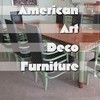
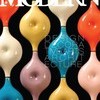
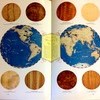
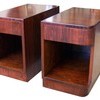
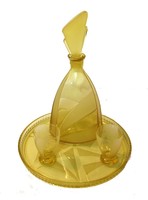
_t.jpg)

_t.jpg)
_t.jpg)
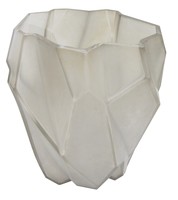
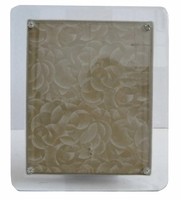

_t.jpg)
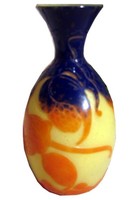

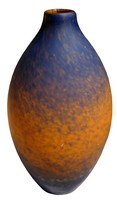

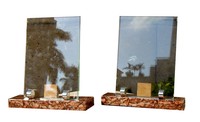
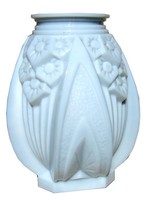
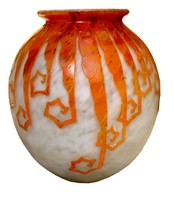
_modernism(1)_t.jpg)
_t.jpg)

_t.jpg)
_t.jpg)

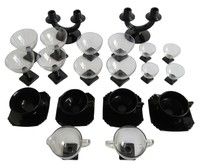
_t.jpg)
_t.jpg)
_t.jpg)
_t.jpg)
(1)_t.jpg)
_t.jpg)
_t.jpg)
_t.jpg)
_t.jpg)
_t.jpg)
_t.jpg)
_t.jpg)
_t.jpg)
_t.jpg)
_t.jpg)
_t.jpg)
_t.jpg)
_t.jpg)
_t.jpg)
_t.jpg)
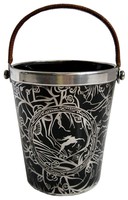
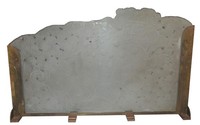
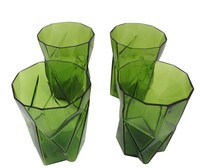
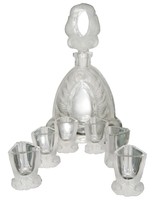
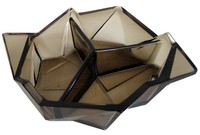
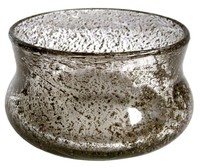
_t.jpg)

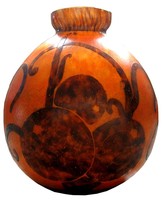


_t.jpg)


_t.jpg)

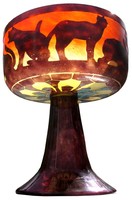
_t.jpg)

1(1)_t.jpg)
_t.jpg)
_t.jpg)
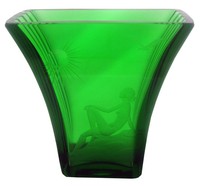
_t.jpg)
_t.jpg)
_t.jpg)
